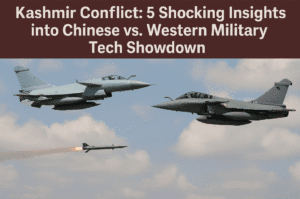Kashmir Conflict: 5 Shocking Insights into Chinese vs. Western Military Tech Showdown
The recent Kashmir conflict has highlighted the growing rivalry between Chinese and Western military technologies, with India deploying French Rafale jets and Pakistan countering with Chinese J-10Cs. This clash marks a rare real-world test of competing systems, such as the J-10C’s PL-15 missiles against the Rafale’s Meteor. The conflict underscores contrasting arms imports: Pakistan’s reliance on Chinese weapons, and India’s diversified arsenal of Western and Russian systems.
This evolving dynamic reveals the broader implications for Indo-Pacific geopolitics, with Chinese weapons gaining traction and India aligning with the West. Despite technological advancements, the outcome depends on strategy and training, as India’s precision warfare contrasts with Pakistan’s reliance on cost-effective systems. Caution remains as both sides avoid heavy reliance on their most advanced assets, signaling potential regional realignments. The key takeaway is that military success hinges on strategy and human factors, not just technology.

Kashmir Conflict: 5 Shocking Insights into Chinese vs. Western Military Tech Showdown
The recent escalation between India and Pakistan over Kashmir has thrust the region into the spotlight as a testing ground for advanced military hardware, pitting Chinese-supplied systems against Western and Russian arms. The clash—sparked by India’s retaliatory strikes against alleged terrorist camps in Pakistan-administered Kashmir—has raised critical questions about the evolving balance of power in South Asia and its implications for global arms dynamics.
Precision Strikes and Aerial Showdowns
India’s Operation Sindoor saw the deployment of French Rafale fighter jets armed with Scalp and Hammer precision-guided munitions, marking the Rafale’s combat debut in the region. Pakistan countered with its Chinese-made J-10C fighters, claiming five Indian aircraft downed, including at least one Rafale—a potential first combat loss for the French jet. Debris from Chinese PL-15E missiles, found in Indian territory, further highlighted Beijing’s role in Islamabad’s defense strategy.
While India denies Pakistan’s claims, the engagement underscores a rare real-world trial of competing technologies:
- J-10C vs. Rafale: The J-10C, equipped with AESA radar and PL-15 missiles (with a reported 200+ km range), challenges the Rafale’s Meteor missile system. Analysts note the PL-15’s range could force adversaries to engage at suboptimal distances.
- JF-17 Block III: Pakistan’s domestically assembled fighter, co-developed with China, integrates similar tech but faces scrutiny after India claimed one was shot down—a claim Islamabad denies.
Arms Imports Reflect Geopolitical Alignments
SIPRI data reveals stark contrasts in procurement strategies:
- Pakistan: 81% of arms imports (2020–24) came from China, including J-10Cs, JF-17s, and HQ-9 air defense systems. This reliance stems from dwindling U.S. support post-2014 and China’s willingness to transfer technology for local production.
- India: Diversified imports include French Rafales, Russian S-400 systems, and U.S. Apache helicopters. Russia remains its largest supplier (36%), but Western systems are increasingly prioritized for interoperability with Quad allies (U.S., Japan, Australia).
Strategic Implications: A Proxy for Indo-Pacific Rivalries?
The conflict offers tentative insights into high-tech warfare but comes with caveats. As Siemon Wezeman of SIPRI notes, “This is the first time advanced Chinese weapons have been tested in high-intensity combat.” Limited engagements favor Pakistan’s strategy of “asymmetric parity,” but India’s numerical and logistical advantages could dominate prolonged conflicts.
Key takeaways for global observers:
- Tech Transfer vs. Readiness: Pakistan’s JF-17 program exemplifies China’s strategy of fostering client states through joint production, while India’s diverse arsenal emphasizes interoperability with Western systems.
- Data Scarcity: Western and Russian systems have decades of combat data; Chinese platforms remain enigmatic. A Rafale loss (if confirmed) might reshape perceptions of European air superiority.
- Indo-Pacific Ramifications: U.S. allies like Taiwan and the Philippines will scrutinize Chinese systems’ performance, while Russia may reassess arms marketing amid India’s pivot to Western tech.
The Human Factor: Training and Doctrine Matter
Technology alone doesn’t decide outcomes. India’s emphasis on long-range standoff strikes (evident in Balakot 2019 and Operation Sindoor) contrasts with Pakistan’s reliance on interception and denial. As defense analyst Shashank Joshi observes, “India’s ability to strike without crossing borders—using satellite-guided bombs—suggests a doctrinal edge in precision warfare.” Pakistan, however, leverages China’s cost-effective systems to offset India’s quantitative lead.
Caution Amid Escalation Risks
Both nations have downplayed nuclear posturing, but miscalculations persist. The 2025 skirmish saw restrained use of advanced assets (e.g., no confirmed S-400 or HQ-9 deployments), hinting at mutual caution. Yet, with China silently backing Pakistan and the U.S. strengthening Indo-Pacific alliances via India, Kashmir’s frozen conflict risks becoming a catalyst for broader regional realignments.
While Chinese weapons have demonstrated potency in Pakistan’s hands, the conflict underscores a timeless truth: hardware is only as effective as the strategy and personnel behind it. For the Indo-Pacific, the real lesson may lie in how middle powers navigate dependency on competing tech blocs in an increasingly fractured world order.
You must be logged in to post a comment.